Tutorial
Basic Lessons
- First-Time Setup and User Interface
- Example 1: A Simple Program
- Exploring Results: Basic Functionality
- Preparing Your Own Program
- Importing Your Own Program
- Creating Program Graphs
Advanced Lessons
- Automatically Finding Optimal Parameter Settings
- Example 2: Multiple Objectives
- Example 3: Parameter Dependencies
- Exploring Results: Advanced Functionality
- HPC and Database Configuration
- Program Graphs With Multiple Programs
Introductory Videos
Exploring Results: Basic Functionality

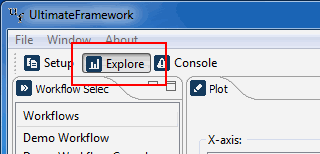 (We use the example database that is shipped with Ultimate Framework.
In case you didn't setup the example database, see the
First-Time Setup lesson for more information.)
(We use the example database that is shipped with Ultimate Framework.
In case you didn't setup the example database, see the
First-Time Setup lesson for more information.)
→ Activate the Explore perspective.

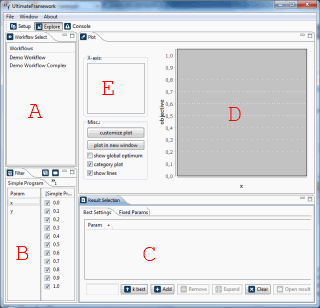 The Explore perspective appears. All algorithm evaluation is
carried out in this perspective.
The Explore perspective appears. All algorithm evaluation is
carried out in this perspective.
A The project list. Here, you select the project you want to evaluate.
B The currently selected filter. Remember that the parameter/value selections mentioned in the previous lesson. These selections can be used in this view as filters: only those parameters and values you choose are used in the evaluation. This enables you to play with the parameter settings to find interesting parameterizations.
C This view displays the parameterization that is considered optimal with respect to the currently active filter. It is currently empty because we didn't tell the Ultimate Framework the k parameter (see below).
D The performance plot. This view displays the performance curves of your algorithm.
E The parameter list. Here, you choose the parameter which shall be visualized by the X-axis of the performance plot.

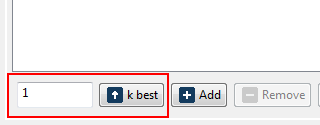 We want to visualize the parameter setting for x and y that
maximizes the objective function of SimpleProgram, i.e., leads to an
optimal evaluation.
We want to visualize the parameter setting for x and y that
maximizes the objective function of SimpleProgram, i.e., leads to an
optimal evaluation.
→ Enter the value 1 in the edit box at the bottom of C and click the k best button.

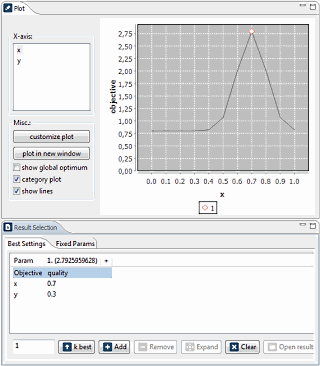 Note the best setting for x (0.7) and y (0.3), displayed in
the Best settings table (C). The performance plot
now shows the complete performance curve for parameter x and emphasizes
the optimal value, which is the peak at 0.7. The parameter list (E)
enables us to choose between x and y.
Note the best setting for x (0.7) and y (0.3), displayed in
the Best settings table (C). The performance plot
now shows the complete performance curve for parameter x and emphasizes
the optimal value, which is the peak at 0.7. The parameter list (E)
enables us to choose between x and y.
→ Let us study the y parameter. In the parameter list (E), select y. Then, enter 4 in the edit box at the bottom of C and click the k best button.

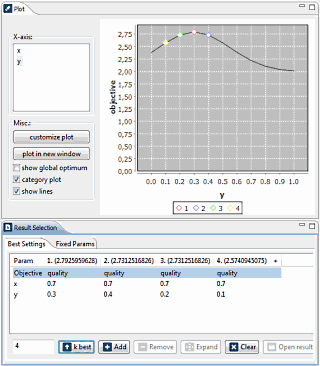 From the best settings table, we now can tell that the best value for the x parameter
is constantly 0.7 within the best 4 settings, but the values for y vary
between 0.1 and 0.4, with 0.3 being the optimal setting. If you click on the
column headers in the table, the performance plot will select the corresponding
data point and highlight it.
From the best settings table, we now can tell that the best value for the x parameter
is constantly 0.7 within the best 4 settings, but the values for y vary
between 0.1 and 0.4, with 0.3 being the optimal setting. If you click on the
column headers in the table, the performance plot will select the corresponding
data point and highlight it.
If you try other settings for k and click the k best button, the data points are added to the table. They do not replace the existing data points. If you want to replace the exiting data points, you have to click the Clear button first.
